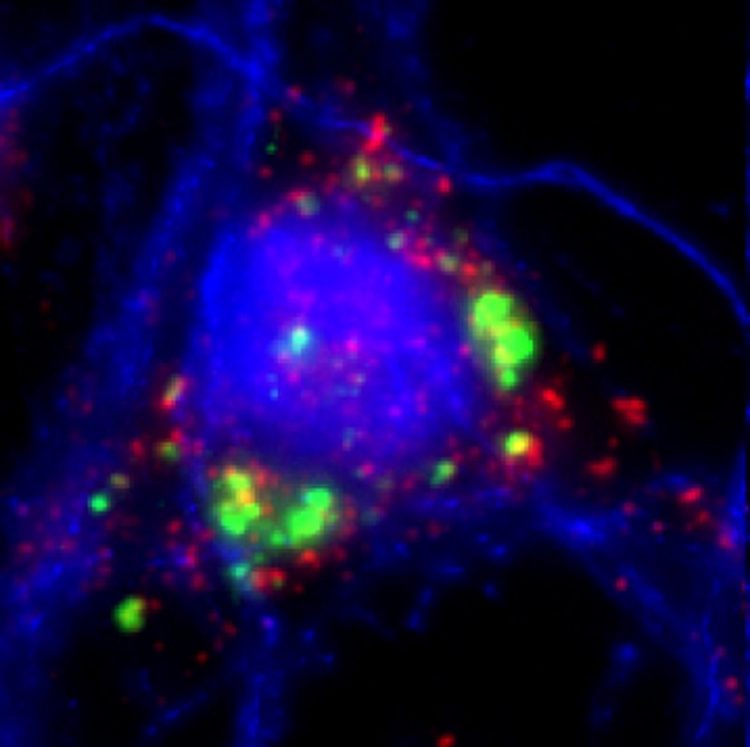Vesicles influence the function of nerve cells

Neurons (blue) which have absorbed exosomes (green) have increased levels of the enzyme catalase (red), which helps protect them against peroxides. photo: Institute of Molecular Cell Biology, JGU
Tiny vesicles containing protective substances which they transmit to nerve cells apparently play an important role in the functioning of neurons. As cell biologists at Johannes Gutenberg University Mainz (JGU) have discovered, nerve cells can enlist the aid of mini-vesicles of neighboring glial cells to defend themselves against stress and other potentially detrimental factors.
These vesicles, called exosomes, appear to stimulate the neurons on various levels: they influence electrical stimulus conduction, biochemical signal transfer, and gene regulation. Exosomes are thus multifunctional signal emitters that can have a significant effect in the brain.
The researchers in Mainz already observed in a previous study that oligodendrocytes release exosomes on exposure to neuronal stimuli. These exosomes are absorbed by the neurons and improve neuronal stress tolerance. Oligodendrocytes are a type of glial cell and they form an insulating myelin sheath around the axons of neurons.
The exosomes transport protective proteins such as heat shock proteins, glycolytic enzymes, and enzymes that reduce oxidative stress from one cell type to another, but also transmit genetic information in the form of ribonucleic acids.
“As we have now discovered in cell cultures, exosomes seem to have a whole range of functions,” explained Dr. Eva-Maria Krämer-Albers. By means of their transmission activity, the small bubbles that are the vesicles not only promote electrical activity in the nerve cells, but also influence them on the biochemical and gene regulatory level.
“The extent of activities of the exosomes is impressive,” added Krämer-Albers. The researchers hope that the understanding of these processes will contribute to the development of new strategies for the treatment of neuronal diseases. Their next aim is to uncover how vesicles actually function in the brains of living organisms.
The study was conducted in cooperation with the group of Professor Heiko Luhmann at the Institute of Physiology at the Mainz University Medical Center and bioinformaticians from the Institute of Molecular Biology (IMB) in Mainz.
Publication:
Dominik Fröhlich, Wen Ping Kuo, Carsten Frühbeis et al.
Multifaceted effects of oligodendroglial exosomes on neurons: impact on neuronal firing rate, signal transduction and gene regulation
Philosophical Transactions of the Royal Society B, 18 August 2014
DOI: 10.1098/rstb.2013.0510
Further information:
Dr. Eva-Maria Krämer-Albers
Institute of Molecular Cell Biology / Biology for Medical Scientists
Faculty of Biology
Johannes Gutenberg University Mainz (JGU)
D 55099 Mainz, GERMANY
phone +49 6131 39-26257
fax +49 6131 39-23840
e-mail: alberse@uni-mainz.de
http://www.uni-mainz.de/FB/Biologie/Molekulare-Zellbiologie
http://www.uni-mainz.de/presse/17633_ENG_HTML.php – press release ; http://rstb.royalsocietypublishing.org/content/369/1652/20130510 – Abstract ;
http://www.uni-mainz.de/presse/16545_ENG_HTML.php – press release “New mode of cellular communication discovered in the brain” (16 July 2013)
Media Contact
All latest news from the category: Life Sciences and Chemistry
Articles and reports from the Life Sciences and chemistry area deal with applied and basic research into modern biology, chemistry and human medicine.
Valuable information can be found on a range of life sciences fields including bacteriology, biochemistry, bionics, bioinformatics, biophysics, biotechnology, genetics, geobotany, human biology, marine biology, microbiology, molecular biology, cellular biology, zoology, bioinorganic chemistry, microchemistry and environmental chemistry.
Newest articles

Largest magnetic anisotropy of a molecule measured at BESSY II
At the Berlin synchrotron radiation source BESSY II, the largest magnetic anisotropy of a single molecule ever measured experimentally has been determined. The larger this anisotropy is, the better a…

Breaking boundaries: Researchers isolate quantum coherence in classical light systems
LSU quantum researchers uncover hidden quantum behaviors within classical light, which could make quantum technologies robust. Understanding the boundary between classical and quantum physics has long been a central question…

MRI-first strategy for prostate cancer detection proves to be safe
Active monitoring is a sufficiently safe option when prostate MRI findings are negative. There are several strategies for the early detection of prostate cancer. The first step is often a…



